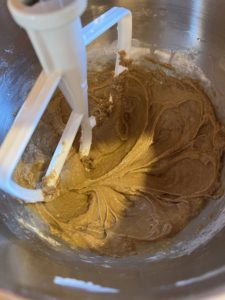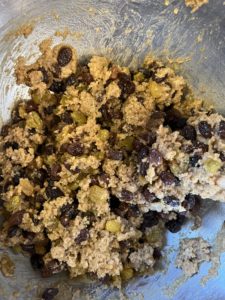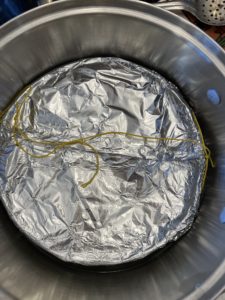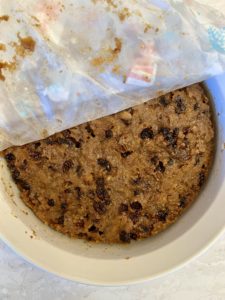A Christmas Carol and Christmas Pudding

One of my favorite seasonal reads from the Victorian era is A Christmas Carol by Charles Dickens. My family and I enjoy the performance of it at the Guthrie Theatre in Minneapolis. I’m happy to share we’ll be going back for the first time in three years this weekend.
I’m in love with the music, ghosts, food—and Christmas pudding! “A great deal of steam! The pudding was out of the copper. A smell like a washing-day! That was the cloth. A smell like an eating-house and a pastrycook’s next door to each other, with a laundress’s next door to that! That was the pudding! In half a minute Mrs. Cratchit entered—flushed, but smiling proudly—with the pudding, like a speckled cannon-ball, so hard and firm, blazing in half of half-a-quartern of ignited brandy, and bedight with Christmas holly stuck into the top” (Dickens, A Christmas Carol).
 After reading about Christmas pudding for years, I decided to try it. Traditionally, Christmas pudding is made on Stir-up Sunday, the Sunday before Advent, and served on Christmas. Over time, the flavors deepen, and brandy acts as a preservative. Christmas pudding is also called figgy pudding and plum pudding. It’s not made with plums, however. It’s made with raisins, which were called plums in the Victorian era. Most recipes suggest soaking the raisins in brandy overnight, which I did. They also suggest adding brandy to the pudding mixture and dousing the pudding with brandy before igniting and serving.
After reading about Christmas pudding for years, I decided to try it. Traditionally, Christmas pudding is made on Stir-up Sunday, the Sunday before Advent, and served on Christmas. Over time, the flavors deepen, and brandy acts as a preservative. Christmas pudding is also called figgy pudding and plum pudding. It’s not made with plums, however. It’s made with raisins, which were called plums in the Victorian era. Most recipes suggest soaking the raisins in brandy overnight, which I did. They also suggest adding brandy to the pudding mixture and dousing the pudding with brandy before igniting and serving.
 Other common ingredients include currants, bread crumbs, apples, and suet. Here I hit a stumbling block, as suet, which is basically the hard lard surrounding the kidneys of animals like cattle and sheep, is not widely available. But I soon found I could use butter, which I did, or Crisco.
Other common ingredients include currants, bread crumbs, apples, and suet. Here I hit a stumbling block, as suet, which is basically the hard lard surrounding the kidneys of animals like cattle and sheep, is not widely available. But I soon found I could use butter, which I did, or Crisco.
The recipe is not hard, just time consuming. After I added the ingredients, I had each person in my family stir the pudding clockwise for good luck in the New Year. If you’ve read or seen Hercule Poirot’s Christmas, you’ll remember that sometimes, little trinkets are added to the pudding as well. I passed on this tradition. I don’t want anyone choking!
 I steamed the pudding for about six hours. I didn’t have a pudding bowl (but you can bet this is on my Christmas list!), so I used a casserole-type bowl that fit inside a large kettle. (Traditionally, a cloth, not a bowl, was used, which explains Dickens’ references.) I placed a trivet on the bottom of the pan and then put in enough water to reach the sides of the pan. Every hour or so, I checked the water and topped it off if needed.
I steamed the pudding for about six hours. I didn’t have a pudding bowl (but you can bet this is on my Christmas list!), so I used a casserole-type bowl that fit inside a large kettle. (Traditionally, a cloth, not a bowl, was used, which explains Dickens’ references.) I placed a trivet on the bottom of the pan and then put in enough water to reach the sides of the pan. Every hour or so, I checked the water and topped it off if needed.
It was a wonderful sound, the bubbling of the pot all day long. I could almost pretend I was in Victorian England. As the time neared six hours, a nice spicy orange smell (I used fresh squeezed orange juice in my pudding) wafted through the air. Glorious!
I won’t be eating it until Christmas, so I can’t vouch for its taste yet, but I think you’ll agree, it looks very promising. If you’d like to try the recipe yourself, here’s the link to the one I used, but there are several others.

Until tasting day, happy baking!
What a culinary adventure! Do let us know how it tastes, please. I learned a lot just reading this, and I think I’ll leave the cooking to you. Enjoy the season!
We ate it Christmas Eve, and it was amazing–although we could not get it to light. My brother-in-law said it was cheap brandy! 🙂